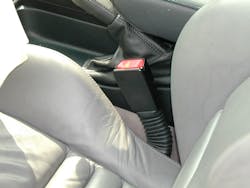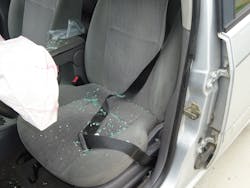University of Extrication: Seatbelt Pretensioners
Topic: Pretensioner update
Objective: Understand seatbelt pretensioner system designs, functions and innovations
Task: Given a scenario of a crashed vehicle, explain how reviewing the condition of the seatbelt and the status of the pretensioner system can provide valuable information about potential mechanism of injury scenarios during the crash
By removing slack from the seatbelt at the moment of a collision, seatbelt pretensioner systems in passenger vehicles keep a belted occupant out of a frontal airbag’s inflation zone as the bag deploys to protect that individual. (If an occupant contacts a deploying airbag during a collision, there is an increased chance of injury to that individual.)
Seatbelt pretensioners primarily are found connected to the front seats and seatbelts in passenger vehicles. Pretensioners are a good feature for occupants who are seated and belted when their vehicle is involved in a frontal or off-set frontal crash.
For EMS responders, they can assist you as you work up potential mechanism of injury scenarios for occupants.
For rescue/extrication personnel, the presence of a pretensioner system doesn’t have a significant influence on extrication tasks. As long as you are aware of their presence and powered down the vehicle, you can go about your work without worrying about the pretensioners.
The original pretensioner systems spin the seatbelt recoiler spool backward by firing off a small pyrotechnic charge. This spool-rewinding action pulls slack out of the seatbelt, which means that the occupant will remain clear of the airbag’s inflation zone during the millisecond that the frontal airbag deploys at the moment the occupant’s vehicle is in a collision.
A second seatbelt pretensioner system pulls down the female seatbelt buckle when its pyrotechnic charge fires at the moment of a crash, therefore removing a slight amount of slack from the seatbelt. It’s most recognizable by an accordion-style rubber covering or sleeve that’s just below the female seatbelt buckle itself.
There are vehicles that are on the road today that have both the spool-rewinding and the buckle-lowering pretensioner system for the same seatbelt. Because both types of pretensioners use a small, self-contained explosive charge to function, the systems are a one-shot deal.
Recent vehicle model years introduced a third type of system that uses an electrically powered design. When sensors that are on the vehicle detect certain conditions, the seatbelt pretensioner quickly spins the take-up spool rearward, removing the slack from the seatbelt system. If no collision occurs and conditions normalize, the system resets itself, which releases its pull on the seatbelt. This design of a pretensioner system, which is used by Mercedes-Benz, among other makers of automobiles, has a pyrotechnic charge that fires if a collision actually occurs and airbags deploy.
A critical design feature of pretensioners for responders to understand is that pretensioners deploy during a crash regardless of whether the seatbelt is being worn. Therefore, when the spool-type system is present and has fired off, it’s possible for EMS personnel to determine whether an occupant was wearing the seatbelt at the moment that the collision occurred.
Because the pretensioner system’s spool locks into place after rewinding, a seatbelt that was worn by an occupant at the moment of the crash and then was unbuckled remains extended, lying limp, and even might hang outside of an open automobile door. This is evidence that the seatbelt was being worn around the occupant at the moment of the collision.
With a seatbelt that wasn’t worn at the time of a crash, the same spool-rewinding system pulls the belt tight, which makes it snug along the inside of the B-pillar.
(In addition to a tight seatbelt, a survey of the interior of the vehicle might reveal several other key factors that indicate an unrestrained occupant: the windshield spider web, a bent/deformed steering wheel ring, a dented instrument panel.)
Document what the patient states to you but also include on the narrative portion of your patient report what you observed yourself regarding the seatbelt system. Finding a loose seatbelt after a crash is good; a tight one along the B-pillar isn’t.
Ron Moore will present “Vehicle Rescue 2021 Update” and “Electric and Autonomous Vehicles” at Firehouse Expo. To register, visit firehouseexpo.com.
Pretensioner System Updates
- The same vehicle can have all three pretensioner designs
- The same seatbelt can have multiple pretensioner systems
- Electrically powered, retractable pretensioner systems recognize a potential crash situation, retract the seatbelt slack, and then relax and reset if no collision occurs
About the Author
Ron Moore
RON MOORE, who is a Firehouse contributing editor, recently retired as a division chief with the McKinney, TX, Fire Department and now serves with Prosper, TX, Fire Rescue. He self-published the Vehicle Rescue 1-2-3 training manual and serves as the forum moderator for the extrication section of Firehouse.com . Moore can be contacted directly at [email protected].



